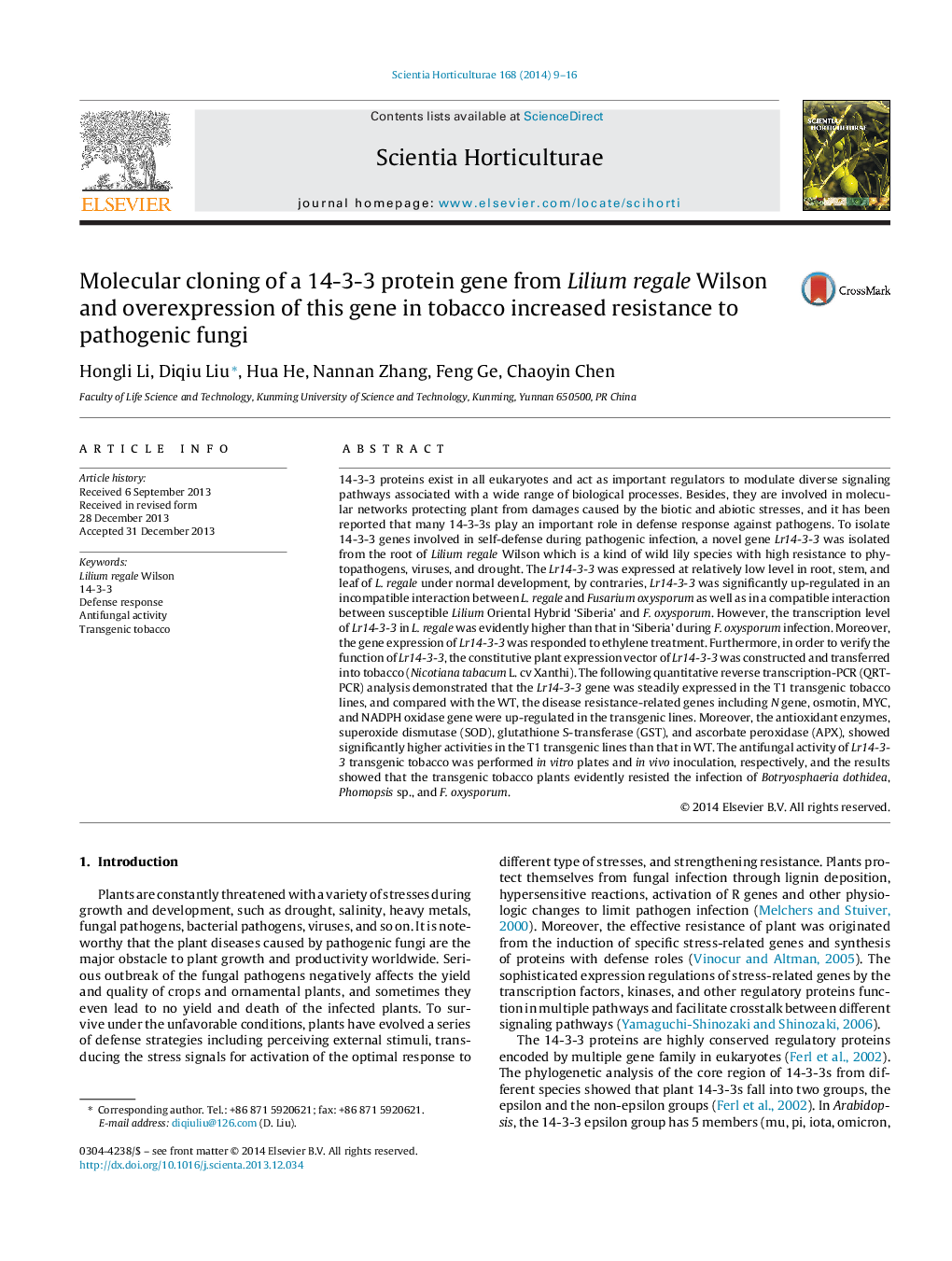| کد مقاله | کد نشریه | سال انتشار | مقاله انگلیسی | نسخه تمام متن |
|---|---|---|---|---|
| 4566886 | 1628830 | 2014 | 8 صفحه PDF | دانلود رایگان |

• A novel 14-3-3 gene Lr14-3-3 was isolated from the root of Lilium regale Wilson.
• Lr14-3-3 was involved in defense response of lily against Fusarium oxysporum.
• Several disease resistance-related genes were induced in Lr14-3-3 transgenic T1 tobacco.
• SOD, GST, and APX activities were increased in the Lr14-3-3 transgenic T1 tobacco.
• The transgenic tobacco showed strong resistance to Botryosphaeria dothidea, Phomopsis sp., and F. oxysporum.
14-3-3 proteins exist in all eukaryotes and act as important regulators to modulate diverse signaling pathways associated with a wide range of biological processes. Besides, they are involved in molecular networks protecting plant from damages caused by the biotic and abiotic stresses, and it has been reported that many 14-3-3s play an important role in defense response against pathogens. To isolate 14-3-3 genes involved in self-defense during pathogenic infection, a novel gene Lr14-3-3 was isolated from the root of Lilium regale Wilson which is a kind of wild lily species with high resistance to phytopathogens, viruses, and drought. The Lr14-3-3 was expressed at relatively low level in root, stem, and leaf of L. regale under normal development, by contraries, Lr14-3-3 was significantly up-regulated in an incompatible interaction between L. regale and Fusarium oxysporum as well as in a compatible interaction between susceptible Lilium Oriental Hybrid ‘Siberia’ and F. oxysporum. However, the transcription level of Lr14-3-3 in L. regale was evidently higher than that in ‘Siberia’ during F. oxysporum infection. Moreover, the gene expression of Lr14-3-3 was responded to ethylene treatment. Furthermore, in order to verify the function of Lr14-3-3, the constitutive plant expression vector of Lr14-3-3 was constructed and transferred into tobacco (Nicotiana tabacum L. cv Xanthi). The following quantitative reverse transcription-PCR (QRT-PCR) analysis demonstrated that the Lr14-3-3 gene was steadily expressed in the T1 transgenic tobacco lines, and compared with the WT, the disease resistance-related genes including N gene, osmotin, MYC, and NADPH oxidase gene were up-regulated in the transgenic lines. Moreover, the antioxidant enzymes, superoxide dismutase (SOD), glutathione S-transferase (GST), and ascorbate peroxidase (APX), showed significantly higher activities in the T1 transgenic lines than that in WT. The antifungal activity of Lr14-3-3 transgenic tobacco was performed in vitro plates and in vivo inoculation, respectively, and the results showed that the transgenic tobacco plants evidently resisted the infection of Botryosphaeria dothidea, Phomopsis sp., and F. oxysporum.
Overexpression of Lr14-3-3 enhanced resistance of transgenic T1 tobacco lines against three plant pathogenic fungi, Botryosphaeria dothidea, Phomopsis sp., and Fusarium oxysporum.Figure optionsDownload as PowerPoint slide
Journal: Scientia Horticulturae - Volume 168, 26 March 2014, Pages 9–16